The Perseids — the "best meteor shower of the year" — are back. Here's how to watch.
The Perseids — one of the most highly anticipated meteor showers — are roaming the night skies once again and they're set to peak this weekend.
The meteor shower began on July 14 and will continue until September 1, according to the American Meteorological Society. It's expected to peak on Aug. 12, and the view won't be hindered by a full moon like last year. Considered the "best meteor shower of the year" by NASA, about 50 to 100 meteors can be seen per hour under ideal conditions.
The Perseids are also known to create fireballs, which are larger explosions of light and color that can last longer than an average meteor streak, NASA says.

What are the Perseids?
The Perseids are particles released from comet 109P/Swift-Tuttle, which was discovered in 1862 by Lewis Swift and Horace Tuttle. It orbits the sun once every 133 years, last passing through the inner solar system in 1992.
The peak will happen as the Earth passes through the dustiest debris of Swift-Tuttle's trails, according to NASA.
The meteor shower's radiant — the area of the sky from which the meteors appear to originate — is located near the constellation of Perseus, the American Meteorological Society said, giving it the name of Perseids.

How to watch the Perseids
The meteors are best seen from the Northern Hemisphere during pre-dawn hours, according to NASA. The agency recommends finding a place with a clear view of the sky and far from bright lights.
NASA suggests lying on your back, allowing your eyes to become adjusted to the dark and staying off your phone. There's no need to look in any particular direction; the meteors can generally be seen all over the sky.
Last year, the Perseids coincided with a full moon, which made catching a glimpse of the meteor shower difficult. The moon during the peak this year will be a waning crescent, so even some of the fainter meteors will be visible.
"People in the U.S. can reasonably expect to see around 40 Perseids in the hour just before dawn on the peak nights. That's about one every couple of minutes, which is not bad," Bill Cooke, who leads NASA's Meteoroid Environment Office, said. "However, we are assuming you are out in the country, well away from cities and suburbs."
In areas with brighter skies, people looking up can expect to see up to 10 meteors an hour.
What's next for astronomy fans?
August will close out with a supermoon, a moon that appears bigger and brighter than the average full moon It will be the second of the month, which means the Aug. 30 event will be a rare blue moon. The term refers to when there are two full moons in a single month — the moon won't actually be blue in color.
Astronomy fans only get to see blue moons about once every three years on average. The next blue moon after Aug. 30 will be in May 2026.
- In:
- Meteor Shower

Christopher Brito is a social media manager and trending content writer for CBS News.
Disclaimer: The copyright of this article belongs to the original author. Reposting this article is solely for the purpose of information dissemination and does not constitute any investment advice. If there is any infringement, please contact us immediately. We will make corrections or deletions as necessary. Thank you.




